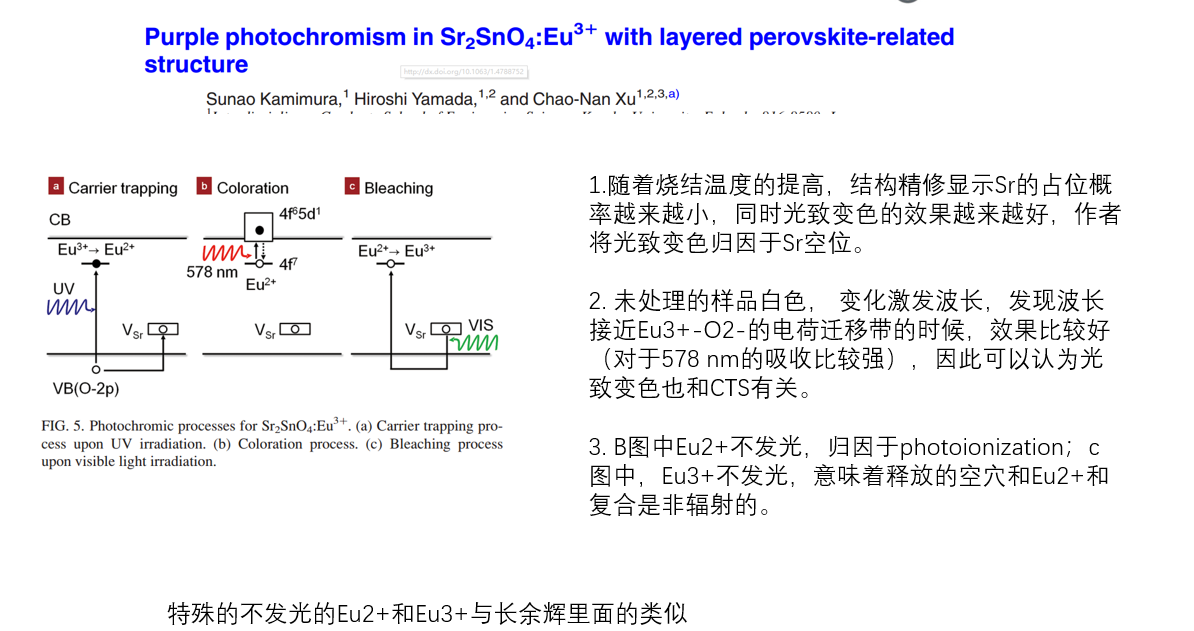参考资料:
(1) ホトクロミック材料-应用物理(日语)-1970
(2) Photochromics-1970
One may "read", "write" and "erase" photochromic materials using light of different frequencies. Lattice defects and impurities are responsible for this potentially useful phenomenon.
—— ZJ Kiss 1970
典型的光/电致变色材料
WO3
电致变色器件(electrochromism device):五层,从左到右依次为
- ITO透明导电基板(接电池+极);
- 离子存储层(Ion storage layer),
- x
- EC layer,mixed
- ITO透明导电基板(接电池-极)。
chromogenic [ˌkrəʊməˈdʒenɪk] 发色的;发色体的
Thin films of amorphous and crystalline WO3都是研究对象,虽然做了很多研究工作,但是解释机理的时候仍然存在许多矛盾的地方。Some of the key experimental results are:
- excitation processes:a variety of excitation processes such as thermal, optical, electrical, ionizing radiation, heating in vacuum, inert and reducing atmosphere, etc., can be used;
- spectrum:spectrum of coloration is essentially similar in all cases with small variations in peak position and half-width;
- structure sensitive:coloration is structure sensitive (peak absorption at 1.2 eV for amorphous and 0.7 eV for crystalline);
- 最高效的材料:coloration occurs most efficiently in highly disordered amorphous films;
- 没有coloaration的材料:fully oxidized crystalline films do not show any coloration except for films formed at high temperature under a reducing atmosphere (vacuum, Ar, H2, etc.);
- 最佳光致变色波长:optical coloration occurs when irradiated with photon energies within the bandgap (maximum at 3.6 eV);
- 环境的影响:both optical and electrical coloration are sensitive to ambient condition—efficiency increases in the presence of H2O (optical); no electrical coloration occurs in vacuum, but thermal, optical, electron- and ion-beam-induced coloration can still occur;
- 掺杂:doping with impurities can affect coloration dynamics;
- 光致变色无法光褪:optically induced coloration generally cannot be bleached with light, but can be bleached electrically;
- 色心光电导:color-center-induced photoconductivity is observed at high electric field at elevated temperature;
- 电子注入和提取:double injection and extraction of electrons and compensating ions is required for reversible electrical coloration;
- 氧气中加热:coloration can be bleached by heating in oxygen, but the coloration efficiency progressively goes to zero;
- coloration is associated with a proportional increase in electrical conductivity (semiconductor→metallic);
- electrical coloration leads to generation of an internal emf that opposes the externally applied field—bleaching is enhanced on shorting the device;
- ESR signal characteristic of the W5+ ion may appear in virgin film, which can increase with coloration;
- thermal coloration on heating (80–330 °C) in vacuum that bleaches on annealing in air—loss of oxygen is observed during some coloration processes;
- dynamics of optical (slower) and electrical coloration (faster) are very different and greatly influenced by film properties (structure and composition), excitation energy, and ambient conditions;
- ion beam (H+, N+, He+, Ar+, Na+, etc.) induced coloration is generally irreversible and absorption increases with oxygen deficiency;
- coloration and bleaching occur in hydrogen- and oxygen-containing gases, respectively, in the presence of a catalyst (Pt, Pd, or Rd) and kinetics of coloration depend on oxygen deficiency and PH2O;
- color center peak position and half-width changes with density of coloration and film properties.
[ACS Applied Materials & Interfaces, 2015, 7(45): 25289-25297.]
So far, several theoretical models have been proposed to interpret the photochromic behavior. For amorphous materials, the models are based on the presence of color center or hydrogen bronze under irradiation; the obvious change in the absorption optical spectra is thought to be caused by the color center,41 intervanlence-charge transfer (IVCT),42 or small-polaron transition.43 However, for some polycrystalline or nanocrystals materials, the light absorption is mainly attributed to the free or trapped charge carriers.44 In present study, the PC behavior and luminescence modulation are simultaneously observed in ferroelectric oxides, and the relevant reaction mechanisms between them are difficultly well described in terms of the existing theoretical models. On the basis of our experimental results and the trapped charge carriers model mentioned earlier, we propose the following luminescence modulation mechanism upon PC reactions, as shown in Figure 10.
经典无机稀土材料
Sr2SnO4:Eu3+
